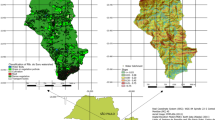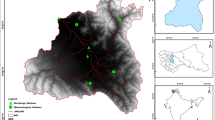Abstract
Understanding the complex relationships between rainfall and runoff processes is necessary to accurately estimate the amount of runoff generated in a catchment. Surface runoff was simulated using the Hydrologic Modeling System (HEC-HMS). The meteorological model was developed within HEC-HMS from rainfall data. To account for infiltration loss and runoff estimation, the methods of the number of soil conservation service curves (SCS-CN) and the unit hydrograph of SCS were used. The assessment of the behavior and performance of the hydrological model is usually performed and reported through simulated and observed variability comparisons. In this work, we used two objective functions (root mean square error (RMSE) and percent error peak discharge (PEPD)) with the observed flood hydrograph for the case of the sub-catchment “W220” for the period of January 1–2, 2019, to examine the sensitivity of these parameters, which can be used to determine preliminary estimation ranges of their values for future modeling.
Access provided by Autonomous University of Puebla. Download conference paper PDF
Similar content being viewed by others
Keywords
1 Introduction
Knowing the volume of runoff in a catchment is important for the sustainable planning and management of water resource projects. Rainfall-runoff models are often used as tools for flow modeling, monitoring of water levels under different water conditions, and flood forecasting (Alfy 2016). Modeling uses a variety of techniques to predict flow, such as physically based distributed models (Ghumman et al. 2017), stochastic models, and global conceptual models (Pham et al. 2018; Anshuman et al. 2018). The uncertainties associated with the results of these models and the identities of their parameters must be examined (Ahmadalipour and Moradkhani 2017). In this study, this task is carried out by performing a sensitivity analysis using the hydrological modeling system of the Hydrological Engineering Center (HEC-HMS). The process of evaluating the performance of a hydrological model requires the hydrologist to make subjective and/or objective estimates of the simulated model behavior to the observed model. Generally, many performance criteria contain an amount of the error term (the difference between the simulated variable and variable observed at each time step) standardized by a measure of variability in the observations. Many researchers have used statistical indicators to evaluate model performance (Gupta et al. 2009; Wang and Solomatine 2018). The objective of this study was to develop a rainfall-runoff model, to assess the runoff volume of the SASAF river catchment and the assessment of catchment behavior from the comparison of two performance indicators for the objective functions namely root mean square error (RMSE) and percent error peak discharge (PEPD) in order to know the parameters that have a high sensitivity on the model output during comparison on the simulated and observed flow hydrograph. In this work, the storm event of 1 and 2 January, 2019, recorded in the period of 1990–2019, was selected for the calibration purpose.
2 Materials and Methods
The analyses were performed in the SAFSAF river catchment (Fig. 1), located in the Northern-East part of Algeria. The area of the catchment is 1165.82 km2.
In this work, the HEC-HMS model was chosen as the flow prediction model and univariate gradient algorithm was used to calibrate the model. In the first time, the analysis was based on the highest daily precipitation recorded at the Skikda precipitation station for 20 years daily data for the period between 1990 to 2019. Effective precipitation, which describes direct runoff, was determined by SCS-CN method. The SCS model based on synthetic unit hydrographs was subjected to the calibration process. In the other hand, the performance calculations of the parameters of the model were carried out at the level of the sub-catchment “W220”, which is the only sub-catchment equipped with a gauging station of KHMAKHAM and automatically calibrated based on the univariate gradient model and two objective functions: PEPD and RMSE. Sensitivity analysis of the parameters was then selected based on their effect on peak flow and total volume.
where Qo and QS are the observed and simulated peak flow.
where Qi, Obs and Qi, Sim are the observed and simulated flow in time step i. N is the number of time steps considered.
3 Results of the Model Performance
Two objective functions were used for the optimization of the parameters of the hydrological model (CN and lag time), namely the root mean square error (RMSE) and the percentage of peak flow error (PEPD). In this part, the optimization was applied to the sub-catchment “W220” which is equipped with a KHMAKHAM gauging station. From this station, we were able to construct the observed flood hydrograph during the period of January 1 and 2, 2019.
4 Discussion
It can be seen from Table 1 and Fig. 2 that there are wide differences among the calibrated performance indicators for the two objective functions. It is clear that the objective functions, RMSE and PEPD, have the best relative error value of volume with -8.82% in the case of the input parameter “Lag time” (Table 1), whereas the objective function RMSE represents the worst relative error value of peak flow with 25.50% in the case of the input parameter “Lag time” (Table 1). The optimization of the CN and lag time parameters by the two objective functions RMSE and PEPD showed that the CN is less sensitive than lag time with regard to the volume. In the case of the objective function RMSE, the CN is more sensitive than lag time with regard to the peak flow. The sensitivity of the CN and lag time in the case of the objective function PEPD is the same with regard to the peak flow (Table 1 and Fig. 2). However, there is change in the time of peak estimated at 1 h when using the PEPD in the case of the input parameter, lag time.
5 Conclusion
In this work, HEC-HMS model and univariate algorithm were applied on the SafSaf River catchment in northeastern Algeria with the aim to assess the effects of different objective functions. Two objective functions and their combinations were chosen to calibrate the model, and their performances were assessed and compared. The smallest differences between the simulated and observed peak flows were obtained using PEPD, and the biggest differences between the simulated and observed volume were obtained using RMSE. A sensitivity analysis was carried out where the parameters of the SCS model have wide variability for both objective functions.
References
Ahmadalipour, A., Moradkhani, H.: Analyzing the uncertainty of ensemble-based gridded observations inland surface simulations and drought assessment. J. Hydrol. 555, 557–568 (2017)
Anshuman, A., Eldho, T.I., Poovakka, A.K.: Performance Evaluation of SWAT with a Conceptual Rainfall Runoff Model GR4J for a Catchment in Upper Godavari River Basin. Indian Institute of Technology Bombay, Powai, India (2018)
El Alfy, M.: Assessing the impact of arid area urbanization on flash floods using GIS, remote sensing, and HEC-HMS rainfall-runoff modelling. Hydrol. Res. 47, 1142–1160 (2016)
Ghumman, A.R., Al-Salamah, I.S., AlSaleem, S.S., Haider, H.: Evaluating the impact of lower resolutions of digital elevation model on rainfall-runoff modelling for ungauged catchments. Environ. Monit. Assess 189, 54 (2017)
Gupta, H.V., Kling, H., Yilmaz, K.K., Martinez, G.F.: Decomposition of the mean squared error and NSE performance criteria: implications for improving hydrological modelling. J. Hydrol. 377, 80–91 (2009)
Pham, M.T., Vernieuwe, H., Baets, B.D., Verhoest, N.E.C.: A coupled stochastic rainfall–evapotranspiration model for hydrological impact analysis. Hydrol. Earth Syst. Sci. 22, 1263–1283 (2018)
Wang, A., Solomatine, D.P.: Practical experience and framework for sensitivity analysis of hydrological models: six methods, three models, three criteria. Hydrol. Earth Syst. Sci. Discuss. (2018) [preprint]. https://doi.org/10.5194/hess-2018-78
Author information
Authors and Affiliations
Editor information
Editors and Affiliations
Rights and permissions
Copyright information
© 2022 The Author(s), under exclusive license to Springer Nature Switzerland AG
About this paper
Cite this paper
Laouacheria, F., Djellit, L., Kechida, S., Chabi, M., Balla, F. (2022). Sensitivity Analysis of the SAFSAF River Catchment Model Using Two Objective Functions. In: Chenchouni, H., et al. New Prospects in Environmental Geosciences and Hydrogeosciences. CAJG 2019. Advances in Science, Technology & Innovation. Springer, Cham. https://doi.org/10.1007/978-3-030-72543-3_106
Download citation
DOI: https://doi.org/10.1007/978-3-030-72543-3_106
Published:
Publisher Name: Springer, Cham
Print ISBN: 978-3-030-72542-6
Online ISBN: 978-3-030-72543-3
eBook Packages: Earth and Environmental ScienceEarth and Environmental Science (R0)






